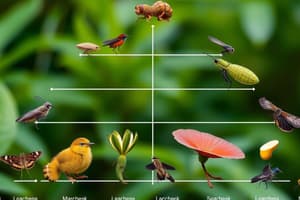Podcast
Questions and Answers
What is the scientific name of noug, a crop native to Ethiopia?
What is the scientific name of noug, a crop native to Ethiopia?
Which of the following crops is NOT identified as having a wide diversity in Ethiopia?
Which of the following crops is NOT identified as having a wide diversity in Ethiopia?
What contributes to Ethiopia's high biological diversity?
What contributes to Ethiopia's high biological diversity?
Which of the following animals is a domesticated species that Ethiopia has served as a gateway for?
Which of the following animals is a domesticated species that Ethiopia has served as a gateway for?
Signup and view all the answers
Which of the following is a correct use of a dichotomous key in biology?
Which of the following is a correct use of a dichotomous key in biology?
Signup and view all the answers
Which genus does the Ethiopian Wolf belong to?
Which genus does the Ethiopian Wolf belong to?
Signup and view all the answers
What is the scientific name for the Ostrich?
What is the scientific name for the Ostrich?
Signup and view all the answers
In which class is the Gelada classified?
In which class is the Gelada classified?
Signup and view all the answers
Which plant species belongs to the family Asteraceae?
Which plant species belongs to the family Asteraceae?
Signup and view all the answers
What type of key is used to identify unfamiliar organisms?
What type of key is used to identify unfamiliar organisms?
Signup and view all the answers
Flashcards
Ethiopian Biodiversity
Ethiopian Biodiversity
Ethiopia has a high variety of plant and animal species, many unique to the region.
Ethiopian crops
Ethiopian crops
Ethiopia is important for crops like teff and noog.
Ethiopian animals
Ethiopian animals
Ethiopia has a variety of domesticated and wild animals.
Dichotomous keys
Dichotomous keys
Signup and view all the flashcards
Endemicity
Endemicity
Signup and view all the flashcards
Scientific name of Ethiopian Elephant
Scientific name of Ethiopian Elephant
Signup and view all the flashcards
Scientific Classification
Scientific Classification
Signup and view all the flashcards
Common Taxon Name
Common Taxon Name
Signup and view all the flashcards
Species
Species
Signup and view all the flashcards
Study Notes
Introduction to Classification
- Organisms are grouped into categories based on shared characteristics.
- This hierarchical organization is called a taxonomic hierarchy.
- Key terms include domain, kingdom, phylum, class, order, family, genus, and species.
- Similarity increases as you move down the hierarchy.
- Species are the most specific group, containing organisms that can interbreed to produce fertile offspring.
Biological Classification
- Classification systems help biologists study the relationships between organisms.
- Classification is important for agriculture, forestry, and medicine.
- There are potential economic benefits from identifying new plant and animal resources that could provide materials for lumber, food, medicine, and energy.
- Taxonomists study evolutionary relationships and genetic similarities of organisms.
- The Linnaean system of nomenclature is used to scientifically name organisms.
Binomial Nomenclature
- Scientific names use Latin, a universal language.
- Scientific names are written using the genus and species names (e.g., Homo sapiens).
- The first name is capitalized, the second is lowercase. Both names are italicized or underlined.
Five-Kingdom System
- Whittaker's five-kingdom system includes Monera, Protista, Fungi, Plantae, and Animalia.
- This system categorizes organisms based on their cell structure, body organization, mode of nutrition, and evolutionary relationships.
Kingdom Monera
- Includes bacteria, which are unicellular and prokaryotic (lack a nucleus).
- Bacteria can be heterotrophic (consuming other organic material) or autotrophic (producing their own food).
- Bacteria live in many different habitats.
Kingdom Protista
- Includes eukaryotic organisms (have nuclei).
- Protists demonstrate variety in structure and function.
- Protists are often single-celled, but some can be multicellular.
Kingdom Fungi
- Includes eukaryotic organisms, many of which are multicellular.
- Fungi are heterotrophic, absorbing nutrients from their environment.
- Fungi are important in decomposition.
Kingdom Plantae
- Includes all eukaryotic and multicellular autotrophic organisms.
- These organisms use photosynthesis for their energy.
- Plants are adapted for stationary existence.
Kingdom Animalia
- Includes all multicellular and heterotrophic organisms.
- Animals have specialized cells (i.e., muscle and nerve cells).
- Animals can move and process sensory input.
- Animalia is broadly separated into invertebrates (no backbone) and vertebrates (with a backbone).
Studying That Suits You
Use AI to generate personalized quizzes and flashcards to suit your learning preferences.
Related Documents
Description
Explore the essentials of biological classification in this quiz, from the taxonomic hierarchy to binomial nomenclature. Understand the importance of grouping organisms based on shared characteristics and the economic implications of classification in various fields. Test your knowledge on the principles that underpin the study of living organisms.




